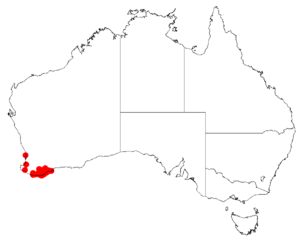Isopogon longifolius facts for kids
Quick facts for kids Isopogon longifolius |
|
|---|---|
| Scientific classification | |
| Genus: |
Isopogon
|
| Species: |
longifolius
|
 |
|
| Where Isopogon longifolius grows in Australia | |
| Synonyms | |
|
Atylus longifolius (R.Br.) Kuntze |
|
Isopogon longifolius is a type of small shrub that belongs to the Proteaceae plant family. It is found only in the southwest part of Western Australia.
What it Looks Like
Isopogon longifolius is a small shrub that usually grows between 1 and 2.5 meters (about 3 to 8 feet) tall. It has smooth branches.
Its leaves are flat and smooth. They grow one after another along the stem. Each leaf is quite long, measuring 85 to 220 millimeters (about 3 to 8.5 inches) in length. They are also 6 to 30 millimeters (about 0.2 to 1.2 inches) wide. The widest part of the leaf is usually above its middle. The edges of the leaves are smooth.
The flowers of this plant grow in clusters, and they are usually cream or yellow in color. These flower clusters are not sticky. The hairy parts of the flower are about 13 to 15 millimeters long. The female part of the flower, called the pistil, is 15 to 20 millimeters long. The part that holds the pollen is smooth and shaped like a spindle, measuring 2.5 to 3.5 millimeters long.
After the flowers, the plant forms a cone that is 24 to 28 millimeters long. This cone has scales that fall off when they are old. Isopogon longifolius usually flowers in January, October, November, or December.
How it Got its Name
This plant was first officially described by a botanist named Robert Brown. He wrote about it in a scientific paper in 1810.
Later, in 1891, another botanist named Otto Kuntze suggested a different name for the plant. He thought it should be called Atylus longifolius. However, most botanists did not agree with his idea.
Because of this, in 1905, a group of plant scientists at the International Botanical Congress decided that the name Isopogon should be the official and accepted name for this group of plants. This means that Isopogon longifolius is the correct scientific name for this shrub today.
The most accepted description of Isopogon longifolius comes from a botanist named Foreman, who wrote about it in 1995 in a book called Flora of Australia.

